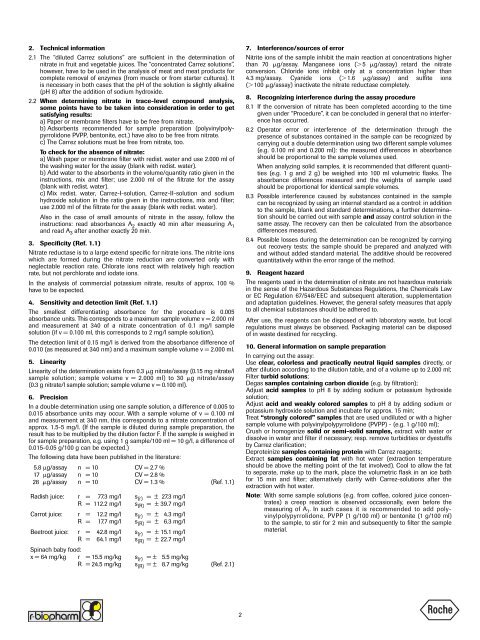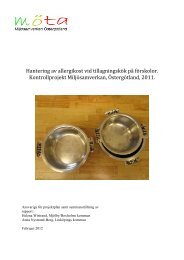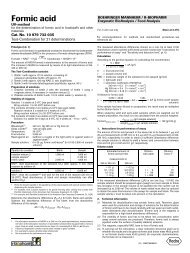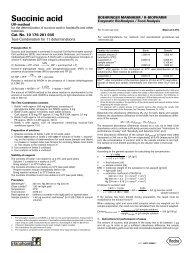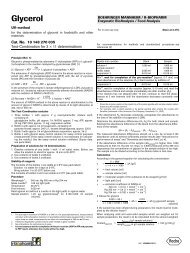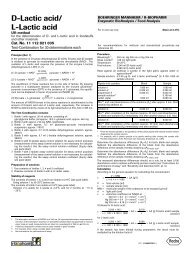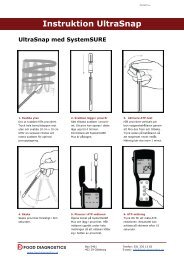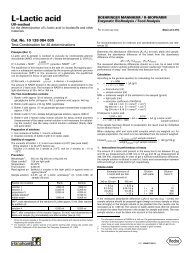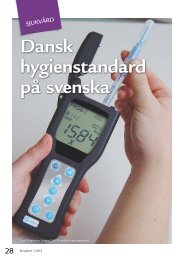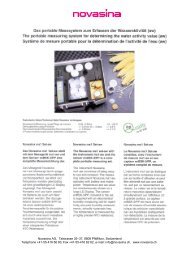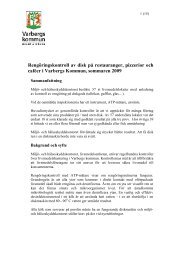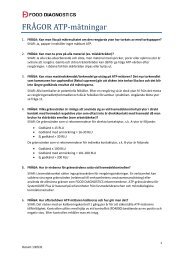Nitrate (NO 3 ) - Food Diagnostics
Nitrate (NO 3 ) - Food Diagnostics
Nitrate (NO 3 ) - Food Diagnostics
You also want an ePaper? Increase the reach of your titles
YUMPU automatically turns print PDFs into web optimized ePapers that Google loves.
2. Technical information<br />
2.1 The “diluted Carrez solutions” are sufficient in the determination of<br />
nitrate in fruit and vegetable juices. The “concentrated Carrez solutions”,<br />
however, have to be used in the analysis of meat and meat products for<br />
complete removal of enzymes (from muscle or from starter cultures). It<br />
is necessary in both cases that the pH of the solution is slightly alkaline<br />
(pH 8) after the addition of sodium hydroxide.<br />
2.2 When determining nitrate in trace-level compound analysis,<br />
some points have to be taken into consideration in order to get<br />
satisfying results:<br />
a) Paper or membrane filters have to be free from nitrate.<br />
b) Adsorbents recommended for sample preparation (polyvinylpolypyrrolidone<br />
PVPP, bentonite, ect.) have also to be free from nitrate.<br />
c) The Carrez solutions must be free from nitrate, too.<br />
To check for the absence of nitrate:<br />
a) Wash paper or membrane filter with redist. water and use 2.000 ml of<br />
the washing water for the assay (blank with redist. water).<br />
b) Add water to the absorbents in the volume/quantity ratio given in the<br />
instructions, mix and filter; use 2.000 ml of the filtrate for the assay<br />
(blank with redist. water).<br />
c) Mix redist. water, Carrez-I-solution, Carrez-II-solution and sodium<br />
hydroxide solution in the ratio given in the instructions, mix and filter;<br />
use 2.000 ml of the filtrate for the assay (blank with redist. water).<br />
Also in the case of small amounts of nitrate in the assay, follow the<br />
instructions: read absorbances A 2 exactly 40 min after measuring A 1<br />
and read A 3 after another exactly 20 min.<br />
3. Specificity (Ref. 1.1)<br />
<strong>Nitrate</strong> reductase is to a large extend specific for nitrate ions. The nitrite ions<br />
which are formed during the nitrate reduction are converted only with<br />
neglectable reaction rate. Chlorate ions react with relatively high reaction<br />
rate, but not perchlorate and iodate ions.<br />
In the analysis of commercial potassium nitrate, results of approx. 100 %<br />
have to be expected.<br />
4. Sensitivity and detection limit (Ref. 1.1)<br />
The smallest differentiating absorbance for the procedure is 0.005<br />
absorbance units. This corresponds to a maximum sample volume v = 2.000 ml<br />
and measurement at 340 of a nitrate concentration of 0.1 mg/l sample<br />
solution (if v = 0.100 ml, this corresponds to 2 mg/l sample solution).<br />
The detection limit of 0.15 mg/l is derived from the absorbance difference of<br />
0.010 (as measured at 340 nm) and a maximum sample volume v = 2.000 ml.<br />
5. Linearity<br />
Linearity of the determination exists from 0.3 g nitrate/assay (0.15 mg nitrate/l<br />
sample solution; sample volume v = 2.000 ml) to 30 g nitrate/assay<br />
(0.3 g nitrate/l sample solution; sample volume v = 0.100 ml).<br />
6. Precision<br />
In a double determination using one sample solution, a difference of 0.005 to<br />
0.015 absorbance units may occur. With a sample volume of v = 0.100 ml<br />
and measurement at 340 nm, this corresponds to a nitrate concentration of<br />
approx. 1.5-5 mg/l. (If the sample is diluted during sample preparation, the<br />
result has to be multiplied by the dilution factor F. If the sample is weighed in<br />
for sample preparation, e.g. using 1 g sample/100 ml = 10 g/l, a difference of<br />
0.015-0.05 g/100 g can be expected.)<br />
The following data have been published in the literature:<br />
5.8 g/assay n = 10 CV = 2.7 %<br />
17 g/assay n = 10 CV = 2.8 %<br />
28 g/assay n = 10 CV = 1.3 % (Ref. 1.1)<br />
Radish juice: r = 77.3 mg/l s (r) =±27.3 mg/l<br />
R = 112.2 mg/l s (R) = ± 39.7 mg/l<br />
Carrot juice: r = 12.2 mg/l s (r) = ± 4.3 mg/l<br />
R = 17.7 mg/l s (R) = ± 6.3 mg/l<br />
Beetroot juice: r = 42.8 mg/l s (r) = ± 15.1 mg/l<br />
R = 64.1 mg/l s (R) = ± 22.7 mg/l<br />
Spinach baby food:<br />
x = 64 mg/kg r = 15.5 mg/kg s (r) = ± 5.5 mg/kg<br />
R = 24.5 mg/kg s (R) = ± 8.7 mg/kg (Ref. 2.1)<br />
7. Interference/sources of error<br />
Nitrite ions of the sample inhibit the main reaction at concentrations higher<br />
than 70 g/assay. Manganese ions (5 g/assay) retard the nitrate<br />
conversion. Chloride ions inhibit only at a concentration higher than<br />
4.3 mg/assay. Cyanide ions (1.6 g/assay) and sulfite ions<br />
(100 g/assay) inactivate the nitrate reductase completely.<br />
8. Recognizing interference during the assay procedure<br />
8.1 If the conversion of nitrate has been completed according to the time<br />
given under “Procedure”, it can be concluded in general that no interference<br />
has occurred.<br />
8.2 Operator error or interference of the determination through the<br />
presence of substances contained in the sample can be recognized by<br />
carrying out a double determination using two different sample volumes<br />
(e.g. 0.100 ml and 0.200 ml): the measured differences in absorbance<br />
should be proportional to the sample volumes used.<br />
When analyzing solid samples, it is recommended that different quantities<br />
(e.g. 1 g and 2 g) be weighed into 100 ml volumetric flasks. The<br />
absorbance differences measured and the weights of sample used<br />
should be proportional for identical sample volumes.<br />
8.3 Possible interference caused by substances contained in the sample<br />
can be recognized by using an internal standard as a control: in addition<br />
to the sample, blank and standard determinations, a further determination<br />
should be carried out with sample and assay control solution in the<br />
same assay. The recovery can then be calculated from the absorbance<br />
differences measured.<br />
8.4 Possible losses during the determination can be recognized by carrying<br />
out recovery tests: the sample should be prepared and analyzed with<br />
and without added standard material. The additive should be recovered<br />
quantitatively within the error range of the method.<br />
9. Reagent hazard<br />
The reagents used in the determination of nitrate are not hazardous materials<br />
in the sense of the Hazardous Substances Regulations, the Chemicals Law<br />
or EC Regulation 67/548/EEC and subsequent alteration, supplementation<br />
and adaptation guidelines. However, the general safety measures that apply<br />
to all chemical substances should be adhered to.<br />
After use, the reagents can be disposed of with laboratory waste, but local<br />
regulations must always be observed. Packaging material can be disposed<br />
of in waste destined for recycling.<br />
10. General information on sample preparation<br />
In carrying out the assay:<br />
Use clear, colorless and practically neutral liquid samples directly, or<br />
after dilution according to the dilution table, and of a volume up to 2.000 ml;<br />
Filter turbid solutions;<br />
Degas samples containing carbon dioxide (e.g. by filtration);<br />
Adjust acid samples to pH 8 by adding sodium or potassium hydroxide<br />
solution;<br />
Adjust acid and weakly colored samples to pH 8 by adding sodium or<br />
potassium hydroxide solution and incubate for approx. 15 min;<br />
Treat “strongly colored” samples that are used undiluted or with a higher<br />
sample volume with polyvinylpolypyrrolidone (PVPP) - (e.g. 1 g/100 ml);<br />
Crush or homogenize solid or semi-solid samples, extract with water or<br />
dissolve in water and filter if necessary; resp. remove turbidities or dyestuffs<br />
by Carrez clarification;<br />
Deproteinize samples containing protein with Carrez reagents;<br />
Extract samples containing fat with hot water (extraction temperature<br />
should be above the melting point of the fat involved). Cool to allow the fat<br />
to separate, make up to the mark, place the volumetric flask in an ice bath<br />
for 15 min and filter; alternatively clarify with Carrez-solutions after the<br />
extraction with hot water.<br />
Note: With some sample solutions (e.g. from coffee, colored juice concentrates)<br />
a creep reaction is observed occasionally, even before the<br />
measuring of A 1 . In such cases it is recommended to add polyvinylpolypyrrolidone,<br />
PVPP (1 g/100 ml) or bentonite (1 g/100 ml)<br />
to the sample, to stir for 2 min and subsequently to filter the sample<br />
material.<br />
2


